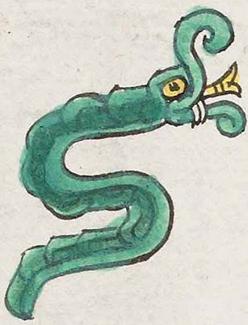Ocuillan (Mdz34r)
This simplex glyph of a worm (ocuilin) also doubles as the glyph for the place name Ocuillan. It is a worm that is facing to our right, its body in the shape of an S. Its eye is yellow and its yellow tongue is protruding and bifurcated. It has two white fangs. Its lips are curled, the upper lip being much larger than the lower. Its body is sculpted or segmented. The center of the worm is a dark green, and the outer edges are a lighter green. The locative suffix (-tlan, going to -lan before a stem ending in l), is not shown visually.
Stephanie Wood
See our Online Nahuatl Dictionary entry for ocuilin to read about worms of sin and worms of Mictlan, the place of the dead. Berdan and Anawalt suggest that this town may refer to the local people, the Ocuilteca, but the norm is that the Ocuilteca (ethnic name) derives from the place name. So, Caterpillar Place might be the better interpretation for this place name. The locative suffix (-tlan) follows a stem ending in l (ocuil-), which means that the t drops away when they are combined, leaving Ocuillan. This worm or caterpillar may be a silkworm. See Wikipedia for images of wild silk worms, which are green and segmented. Silk production was significant in early Mexico, and can still be found as a cottage industry in the Mixteca, state of Oaxaca.
Stephanie Wood
ocuilan. puo
Ocuillan, pueblo
Stephanie Wood
c. 1541, or by 1553 at the latest
worms, caterpillars, gusanos, orugas, gangs, colmillos, topónimos, pueblos, altepetl, nombres de lugares

ocuilin, worm, https://nahuatl.wired-humanities.org/content/ocuilin
-tlan (locative suffix), https://nahuatl.wired-humanities.org/content/tlan
"Where There Are Many Ocuilteca" or "Where There Are Many Caterpillars" (Berdan and Anawalt, 1992, vol .1, 196)
Codex Mendoza, folio 34 recto, https://digital.bodleian.ox.ac.uk/objects/2fea788e-2aa2-4f08-b6d9-648c00..., image 78 of 188.
Original manuscript is held by the Bodleian Libraries, University of Oxford, MS. Arch. Selden. A. 1; used here with the UK Creative Commons, “Attribution-NonCommercial-ShareAlike 3.0 License” (CC-BY-NC-SA 3.0)


